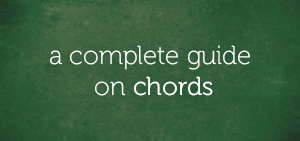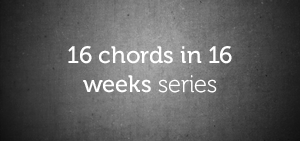I get tons of e-mails asking me how to spice up old chord progressions. So this month, I will introduce a couple of “spicy” progressions that you can play in the place of classic progressions like “2-5-1’s” or “6-2-5-1’s!”
I will start by giving you a basic way to play the progression. I will then show you how to “spice up” the same progression.
#1) Key of F major
This example is based on a “7-3-6” progression. If you remember, last time, we covered “7-3-6-2-5-1” progressions. A “7-3-6” is simply an abbreviation of the larger progression.
For simplicity, I will post one of the progressions that you learned last month. Now… keep in mind, that this progression is pretty contemporary in and of itself. However, there are ways to take an “already-contemporary” progression and spice it up as you’ll see below.
NOTES IN PARENTHESIS ( ) DON’T NECESSARILY HAVE TO BE PLAYED IF YOU CAN’T REACH THEM.Common Example of 7-3-6 progression:
Left hand E + B + D (“7”) |
Right hand G + B + D + F# + (A) |
| A + E + G (“3”) | Db + F + G + C |
| D + A + C (“6”) | C + E + F + A + C |
Now… let’s spice it up a little bit!
Ok, to start:
For the “7” chord above, let’s replace the left hand with a tritone: “G+Db.”
BUT INSTEAD OF PLAYING JUST A TRITONE ON THE LEFT, we will add an “F” to create this three-fingered triad:
G + Db + F
TIP: When spicing up your chords, sometimes the lowest note won’t correspond with the traditional way to play a progression. You’ll be playing things like “tritones,” various inversions of the left hand, altered chords, and more! So don’t worry about trying to decipher why a “G” is the lowest note instead of an “E” (like in the common example above). As you’ll notice, the same type of sound will be produced, but more jazzier. The end result is always more important — that is, you’ll still end up going to the “6” chord, which is on “D.“
So, let’s continue:
On the left, we will play G+Db+F, which is like a G7 (b5), but very abbreviated.
On the right hand, we will simply play a Gbmaj triad (Db + Gb + Bb) in its second inversion. Let’s look at the whole chord now:
| Left hand | Right hand |
| G + Db + F | Db + Gb + Bb |
The next chord is pretty simple. Just take the left hand chord you’re playing and move the “F” to “E” so that you get this chord:
G + Db + E <<<<<<<<<<<< Left hand.
Now for the right hand, simply move the Gbmaj triad to an Fmaj triad. That means moving (Db+Gb+Bb) down to (C+F+A).
C + F + A <<<<<<<<<<<< Right hand.
The entire chord will look like this:
|
Left hand |
Right hand |
|
G + Db + E |
C + F + A |
Now, we will look at the last chord of this series.
Very very simple again.
Tip: With a lot of these “spicier” voicings, it’s not all about playing huge chords. In actuality, a lot of these “spicier” voicings are simply two small chords combined (aka “polychords”). Play around with smaller chords until you come up with sounds that you’ve never heard before. You’ll surprise yourself!
| Left hand | Right hand |
| D + A + C | C + E + G |
So as you can see, this last chord is simply a D7 on the left and a Cmaj triad on the right.
Now, let’s combine all three chords for our final “7-3-6” progression:
|
Left hand |
Right hand |
|
G + Db + F |
Db + Gb + Bb |
|
G + Db + E |
C + F + A |
| D + A + C | C + E + G |
#2) Key of Ab major
The following progression can be used to replace a classic “6-2-5-1.” So that you understand how a “6-2-5-1” might normally be played, I have listed one below for you:
A ” / ” slash means that the note to the right will be played on the bass (left hand).
|
“1” |
“6” |
“2” |
“5” |
“1” |
|
Bb Eb Ab / Db |
Ab C Db F / Bb |
Gb Bb Db F / Eb |
C F A / Ab |
Bb Eb Ab / Db |
Note: The “1” chord has been added above just to give you a sense of what chord a “6” would proceed.
Now replace the same chords above with these:
| Left hand | Right hand |
| Eb + Ab | Db + F + Ab + Db |
| D + Ab | C + E + G + C |
| Eb + Bb + Db | G + B + Db + Gb |
| Ab + Eb + Gb | Gb + Bb + C + F |
… So can you tell the difference?
What do I do next?
Start learning these progressions in all twelve keys! Just because I played them in F and Ab major doesn’t mean you have to be confined to those major keys. Use our 300-pg course to figure out how to transpose these chords into other keys.
Remember, chords have different functions. Try using the chords above in other keys. For example, though the second example I listed was posted in Ab as a “6-2-5-1” progression, isn’t it true that an F to Bb to Eb to Ab is also a “3-6-2-5” in the key of Db major? So in essence, what might be one progression in one key WILL BE A TOTALLY DIFFERENT PROGRESSION in another key! Try those same chords out and see if they work. You’ll be surprised at the results.
So once you learn the progressions in all keys, then start mixing and matching their roles. Use them as “2-5-1s” in some keys but as “1-4” progressions in others! You’ll see the power of this technique as soon as you start using it!
Well, I hope you enjoyed June’s newsletter and I’ll be back in July! Take care!







Comments on this entry are closed.